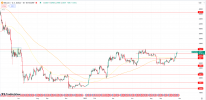US INDICES:

Stock Futures Decline with Surging Treasury Yields, Concerns Over Prolonged Fed Tightening
Stock futures declined on Tuesday as traders closely monitored the surging Treasury yields, which reached their highest point in 16 years. S&P 500 futures decreased by 0.5%, and Nasdaq 100 futures fell by 0.6%.
The 10-year Treasury yield stood at 4.735%, marking its highest level since August 15, 2007. This significant increase in the benchmark yield has occurred over the past month as traders assess the possibility of a more prolonged Federal Reserve tightening.
Investors have become increasingly concerned about the potential impact of an extended period of tighter Federal Reserve policies, worrying that this could potentially lead the economy into a recession. Consequently, Treasury yields have reached levels not witnessed in over a decade.
On the economic front, investors are closely awaiting the release of the Job Openings and Labor Turnover Survey for August, scheduled for Tuesday morning. According to economists surveyed by Dow Jones, there is an anticipation of 8.8 million job openings.
On the weekly Nasdaq chart, a double top pattern has been confirmed, with the neckline located in the 14,250-14,500 area. A breakout above these levels could lead the price toward the 200-day moving average on the daily chart and the lower boundary of the current long-term bullish channel..
USOIL

Oil Prices Fall on Stronger Dollar, Global Economic Concerns, and Mixed Supply Signals
Oil prices declined on Tuesday due to a stronger U.S. dollar, global economic concerns, and mixed supply signals. Brent futures dropped 56 cents to $90.15 a barrel, while U.S. West Texas Intermediate crude (WTI) fell 42 cents to $88.4 per barrel. The U.S. dollar reached a 10-month high against major currencies, making oil more expensive for other currency holders and potentially reducing demand. Turkey's announcement of resuming operations on a suspended Iraq pipeline also weighed on prices. OPEC+ is expected to maintain its output policy, but uncertainty prevails in the market. Saudi Arabia is likely to raise its November crude prices for Asia.
WTI is making the fourth consecutive selling day but finding support at the 87.8 level while forming a possible double top signaling a possible continuation of correction. If this happens the 86 level may play a solid support.
Crypto

Cryptocurrency Prices Decline with Surge in Bond Yields and Lackluster ETF Launch
Bitcoin and other cryptocurrencies saw a decline on Tuesday following a recent rally, primarily due to a surge in bond yields, which added pressure to risk-sensitive assets. Additionally, the lackluster launch of a cryptocurrency exchange-traded fund (ETF) added to the negative sentiment.
Bitcoin's price dropped by 3% in the past 24 hours, falling below $27,600 after briefly reaching $28,500 on Monday. Despite this slide, Bitcoin remained above the $26,000 mark, which has been a significant trading level for nearly two months, characterized by low volatility and trading volumes.
Adding to concerns, the launch of an ETF holding futures contracts for Ether, the second-largest digital asset after Bitcoin, was underwhelming. While seven Ether futures ETFs began trading after receiving clearance from the Securities and Exchange Commission, they saw minimal trading activity, with less than $2 million in dollar value traded within their first 15 minutes. This muted launch contrasted with the successful debut of the ProShares Bitcoin Strategy ETF, which traded $200 million in volume within its initial 15 minutes.
Overall, these developments suggest a potential waning of investor interest in cryptocurrencies, including Ether, and raise doubts about the significance of a Bitcoin spot ETF as a market catalyst. Ether's price fell by 4% to $1,660.
Bitcoin found resistance levels at the 100 and 200MA on the daily chart at the 28070 level. The price is forming a range indicating uncertainty. 25000 and 28000 are the support resistance of the actual range.

Stock Futures Decline with Surging Treasury Yields, Concerns Over Prolonged Fed Tightening
Stock futures declined on Tuesday as traders closely monitored the surging Treasury yields, which reached their highest point in 16 years. S&P 500 futures decreased by 0.5%, and Nasdaq 100 futures fell by 0.6%.
The 10-year Treasury yield stood at 4.735%, marking its highest level since August 15, 2007. This significant increase in the benchmark yield has occurred over the past month as traders assess the possibility of a more prolonged Federal Reserve tightening.
Investors have become increasingly concerned about the potential impact of an extended period of tighter Federal Reserve policies, worrying that this could potentially lead the economy into a recession. Consequently, Treasury yields have reached levels not witnessed in over a decade.
On the economic front, investors are closely awaiting the release of the Job Openings and Labor Turnover Survey for August, scheduled for Tuesday morning. According to economists surveyed by Dow Jones, there is an anticipation of 8.8 million job openings.
On the weekly Nasdaq chart, a double top pattern has been confirmed, with the neckline located in the 14,250-14,500 area. A breakout above these levels could lead the price toward the 200-day moving average on the daily chart and the lower boundary of the current long-term bullish channel..
USOIL

Oil Prices Fall on Stronger Dollar, Global Economic Concerns, and Mixed Supply Signals
Oil prices declined on Tuesday due to a stronger U.S. dollar, global economic concerns, and mixed supply signals. Brent futures dropped 56 cents to $90.15 a barrel, while U.S. West Texas Intermediate crude (WTI) fell 42 cents to $88.4 per barrel. The U.S. dollar reached a 10-month high against major currencies, making oil more expensive for other currency holders and potentially reducing demand. Turkey's announcement of resuming operations on a suspended Iraq pipeline also weighed on prices. OPEC+ is expected to maintain its output policy, but uncertainty prevails in the market. Saudi Arabia is likely to raise its November crude prices for Asia.
WTI is making the fourth consecutive selling day but finding support at the 87.8 level while forming a possible double top signaling a possible continuation of correction. If this happens the 86 level may play a solid support.
Crypto

Cryptocurrency Prices Decline with Surge in Bond Yields and Lackluster ETF Launch
Bitcoin and other cryptocurrencies saw a decline on Tuesday following a recent rally, primarily due to a surge in bond yields, which added pressure to risk-sensitive assets. Additionally, the lackluster launch of a cryptocurrency exchange-traded fund (ETF) added to the negative sentiment.
Bitcoin's price dropped by 3% in the past 24 hours, falling below $27,600 after briefly reaching $28,500 on Monday. Despite this slide, Bitcoin remained above the $26,000 mark, which has been a significant trading level for nearly two months, characterized by low volatility and trading volumes.
Adding to concerns, the launch of an ETF holding futures contracts for Ether, the second-largest digital asset after Bitcoin, was underwhelming. While seven Ether futures ETFs began trading after receiving clearance from the Securities and Exchange Commission, they saw minimal trading activity, with less than $2 million in dollar value traded within their first 15 minutes. This muted launch contrasted with the successful debut of the ProShares Bitcoin Strategy ETF, which traded $200 million in volume within its initial 15 minutes.
Overall, these developments suggest a potential waning of investor interest in cryptocurrencies, including Ether, and raise doubts about the significance of a Bitcoin spot ETF as a market catalyst. Ether's price fell by 4% to $1,660.
Bitcoin found resistance levels at the 100 and 200MA on the daily chart at the 28070 level. The price is forming a range indicating uncertainty. 25000 and 28000 are the support resistance of the actual range.























































